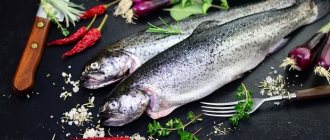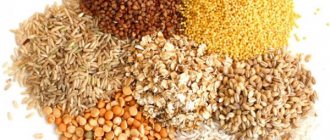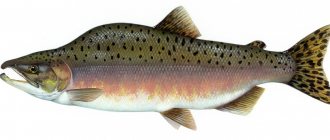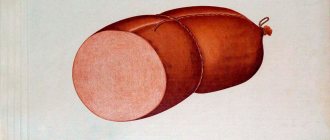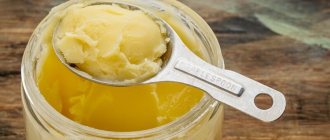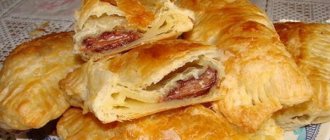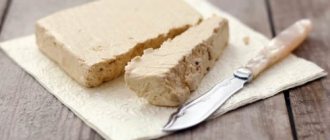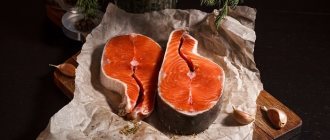Blue whiting fish: vitamins and microelements
In the fish departments there are two types of blue whiting: northern and southern.
The difference between the species is in size. If the northern ones reach a length of no more than 35 centimeters and weigh about 700 grams, then individuals of the second species are much larger: 55 centimeters with a weight of up to 1.3 kilograms. The composition of useful elements is approximately the same for both varieties. Vitamins
| Name | Content per 100 grams |
| A | 39.871 mcg |
| IN 1 | 0.39 mg |
| E | 0.388 mg |
| WITH | 1.366 mg |
| RR | 5.597 mg |
| AT 2 | 0,094 |
In addition to vitamins, the usefulness of fish meat is due to the micro and macroelements it contains.
By consuming fish, a person receives the components necessary for health:
- iron;
- fluorine;
- copper;
- iodine;
- molybdenum;
- chromium;
- manganese;
- zinc;
- magnesium;
- phosphorus;
- calcium.
The product also contains omega-3 and omega-6 fatty acids, which are important for the human body. The substances have a positive effect on the functioning of the nervous system, reduce the level of “bad” cholesterol, preventing the formation of atherosclerotic plaques.
Fish contains up to 1.2% fat, and therefore belongs to low-fat varieties. Dietary meat is well digestible, it is allowed to be consumed by pregnant women and children as the first fish food (at 10 months).
Composition and calorie content
Fish is a low-fat, low-calorie variety. The energy value of 100 g of raw fillet is 81.224 kcal. Calories will vary slightly depending on cooking method.
Be sure to read:
Pike-perch fish: benefits and harm, how many calories, how to reduce calories, is it possible to lose weight
Almost all the protein contained in fish has an optimal amino acid structure, which makes it possible to provide the child’s body with “building material” for cell growth, to compensate for the lack of protein during heavy physical exertion or after intense sports.
According to the BJU formula, 100 grams of fresh blue whiting contains:
- up to 19 g of proteins;
- less than 1 g of fat (this fish is the least fatty of the cod fish).
There are no carbohydrates in the composition. Moreover, about 23% of the fats present in blue whiting are omega-3 polyunsaturated acids that are beneficial to the body. Another 6% of fats are healthy omega-6 acids, while harmful saturated fats are practically not contained in this fish.
And also 100 g of fresh product contains:
- about 40 mcg of vitamin A;
- up to 40 mcg of vitamin B1;
- about 100 mcg of vitamin B2;
- up to 1.4 mcg vitamin C;
- up to 400 mcg of vitamin E;
- about 6 mg of vitamin PP.
The chemical composition of this product is very rich and includes:
- phosphorus;
- copper;
- cobalt;
- iron;
- fluorine;
- chromium;
- magnesium;
- chlorine;
- iodine;
- molybdenum;
- zinc;
- nickel;
- manganese;
- potassium;
- calcium;
- sodium;
- sulfur
The calorie content of fresh blue whiting is 82 thousand calories per 100 grams of product, which is quite low even by the standards of dietary fish varieties. Heat treatment noticeably changes both the energy value and composition of this fish.
The composition and its properties change the least after cooking: its calorie content even decreases and is about 75 kcal per 100 grams, vitamins and microelements are retained almost completely, and the composition of the BJU looks like this:
- 14% proteins;
- 0.7% fat;
- less than 0.1% carbohydrates.
Baked whiting has a similar composition and a slightly higher calorie content: about 80 kcal per 100 g. The fish soup from this fish will retain all its beneficial properties, while 100 g of such soup will have a calorie content of only 31 kcal. Stewing does not cause a noticeable decrease in the amount of valuable substances contained in the product, while the calorie content of the product increases (up to 87 kcal per 100 g), and the BZHU formula takes the form:
- 16% proteins;
- 0.6% fat;
- 0.4% carbohydrates.
But frying noticeably reduces the vitamin content in dishes prepared from blue whiting. At the same time, the calorie content of the product, depending on the type of oil used in cooking, can reach 135 kcal per 100 g. And frying also leads to a noticeable increase in fat content, as a result, the ratio of BJU for fried fish looks like this:
- up to 23% proteins;
- up to 2.5% fat;
- 0.5% carbohydrates.
Fish cutlets made from this product will have an energy value of about 115 kcal per 100 g. At the same time, the amount of vitamins in them will be slightly reduced relative to the fresh product. The calorie content of this product in dried and dried form increases more than 2 times: up to 260 and 200 kcal per 100 g, respectively.
But drying and drying allows you to preserve almost all the vitamins and minerals in the composition. The energy value of the product in salted and smoked form is almost no different from the values typical for boiled fish. But the amount of fat may increase slightly, although not as significantly as in the case of frying.
Hot smoked recipe
To make delicious hot smoked whiting, you need to use a suitable smoker that maintains the desired temperature and does not release too much smoke. It is difficult to make a unit manually, but you can order a suitable design in the store.
The method involves short-term treatment of carcasses with smoke from alder chips or fruit trees. To properly smoke blue whiting, you should adhere to the following technology:
- Light the fire, sprinkle the sawdust with water, and place it at the bottom of the smokehouse. The smoke from the wood chips adds a unique taste and aroma to the dish. Smoke treatment is also responsible for the golden hue of the finished product.

- To prepare 1 kg of fish, marinate it - place it in an enamel basin, rub it with spices and salt, after removing the entrails. The fire is lit in 15-20 minutes. until smoking.
- After 15 minutes, the carcasses are removed, washed and dried. As soon as smoke starts to appear from the wood chips in the smokehouse, the fish is placed on the grates or hung on hooks.

- Cover the smokehouse with a lid and cook for 35-40 minutes. It is important to maintain medium heat. If sawdust burns strongly, it will begin to release carcinogens, which will affect the benefits and taste of the product and make it bitter.

After cooking, the carcasses need to ventilate for 20-30 minutes in the fresh air. Serve fish with vegetables.
Blue whiting for weight loss
Fish carcass contains few calories, and the meat eaten quickly fills you up due to the intake of easily digestible protein. These properties make blue whiting one of the foods suitable for weight loss.
The number of calories in blue whiting dishes depends on the cooking method.
| Recipe | Calorie content in kcal |
| Ear | 31 |
| Boiled fillet | 85 |
| Steamed fish cutlets | 114 |
| Grilled | 116 |
| Fried in oil | 135 |
| Cold smoked | 145 |
| Dried | 249 |
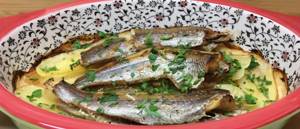
For weight loss, fish boiled in a small amount of water, as well as steamed or grilled fish, is good. Food allows you to lose extra pounds without the discomfort that often arises due to dietary restrictions.
Preparing for smoking
Salting blue whiting before smoking is necessary for both hot and cold cooking methods. Marinating will help destroy harmful bacteria and prepare the meat for cooking. This is especially important for fish that is smoked using cold technology.

In stores, blue whiting is often sold frozen. It is better to buy one with a small layer of ice. If possible, evaluate your eye color. They should not be cloudy. When purchasing chilled fish, you need to pay attention to the elasticity of the carcass and the absence of dull mucus on the scales.
Advice! You should not purchase fish if it has a foreign odor, or if there are tears in the meat or other damage.
Immediately after purchase, you should begin preparing blue whiting for smoking at home. Do not defrost fish in hot water. An option with a microwave or just in the sink is suitable. Most microwave appliances are equipped with an automatic defrost mode.
Then they begin cleansing: they remove the insides, carefully cutting out the gallbladder, and remove the film covering the abdomen from the inside. You can leave the head, but you need to throw out the gills, otherwise after smoking the fish will have a specific taste.

Next we start pickling, there are 2 basic recipes:

Dry salting.
To process whiting, a mixture of pepper and salt is used, which draws excess moisture from the fibers and destroys harmful microorganisms. The abundance of salt improves the storage of the finished product. There should be no more than 1 tsp of pepper. for 2-3 tbsp. l. salt. Each carcass is well rubbed inside and out, placed in a plastic or enamel container, and placed in a cool place for 3-4 hours. After salt treatment, the carcasses are washed and dried. You can then soak the fish for 30-60 minutes.
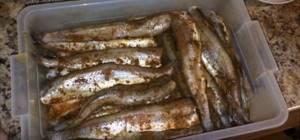
Liquid pickling.
For the marinade, take 1 part salt and 10 parts water. First boil the water, add 1-2 bay leaves and other spices. You can use ready-made fish seasoning. The carcasses are soaked in brine for at least 3-4 hours.
Dry pickling is used for hot smoking, and marinade is suitable for cold smoking. There are other options, for example, with vinegar and lemon. But this salting method requires further heat treatment. But it is suitable for quick preparation - it is enough to keep the fish in the mixture for 1 hour.
You can marinate carcasses in unrefined vegetable oil by mixing 10 parts of it with one part of salt. Spicy herbs and seasonings will add aroma.
Benefit
Regular consumption of fish dishes will benefit the human body:
- bones will become stronger;
- damaged or atrophied muscle tissue will be restored;
- the condition of hair, nails and skin will improve;
- metabolism is normalized;
- the risk of developing atherosclerosis or thrombosis will be reduced;
- memory will improve;
- skin damage caused by illness or injury (burns, wounds, psoriasis, trophic ulcers) will heal faster;
- sleep will improve;
- Nervousness and irritability will disappear.
For pregnant women, fish dishes will ensure the full development of the fetus and reduce the likelihood of disturbances in the formation of the nervous and musculoskeletal systems.
Fish will cause serious harm to the human body only if there is a history of allergies to seafood.
When eating fish dishes, you may experience:
- skin rash;
- digestive disorders (diarrhea, vomiting, abdominal pain);
- difficulty breathing.
Be sure to read:
Trout: benefits and harm, how many calories are in 100 grams, BJU, what calorie content depends on
With severe allergic manifestations, angioedema or anaphylaxis may develop - conditions are life-threatening and require emergency medical attention. To avoid serious consequences, you should carefully include a new product in the menu.
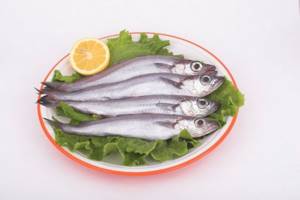
Fish can also be harmful to people suffering from kidney failure - this disease limits protein intake.
Unpleasant sensations can be caused by overuse of blue whiting. The daily allowance for fish dishes is 250 grams, and if you eat more, it will cause stomach upset.
Any whiting dish is healthy. Fish can be boiled, fried, baked or made into cutlets, diversifying your diet. But you need to observe moderation: the product is useful only as part of a balanced menu.
A mono-diet, when you eat only blue whiting, is harmful due to the fact that the fish cannot provide the body with all the necessary substances. And it should be remembered that the product is not suitable for everyone - it should not be consumed by people on a low-protein diet or with a history of allergies to seafood.
Do you like blue whiting?
The combination of low calorie content even by the standards of dietary products, the absence of carbohydrates, fat content of less than 1% and a high concentration of vitamins and substances beneficial to human health make blue whiting a good choice for inclusion in diets intended for weight loss. In addition, consuming blue whiting at least 3 times a week, due to its significant phosphorus content, leads to a noticeable improvement in the functioning of the brain and nervous system as a whole.
Omega acids are well-known antioxidants, so consuming foods containing them, including sea fish, reduces the rate of aging of the body and prevents the development of malignant tumors.
Eating blue whiting also has a beneficial effect on the function of the gastrointestinal tract, as well as the liver and pancreas. High iron content helps alleviate anemia and improve oxygen supply to tissues.
The main contraindication to eating blue whiting is an allergy to fish and other seafood or individual intolerance to certain substances that make up it: for example, iodine, iron and phosphorus. Consumption of fish by persons allergic to it can lead to serious consequences, including the development of anaphylactic shock.
Since on an industrial scale this fish is caught exclusively by fishing in the open ocean and is almost never bred in closed fish farms, you can be sure that all of it grew up on exclusively natural food. Unfortunately, this absolutely positive fact also has a downside: like many other types of Pacific fish, blue whiting is often infected with various parasites.
Another disadvantage is the characteristic unpleasant odor that accompanies the cooking process of this fish. Therefore, it is worth ventilating the kitchen while preparing this product.
See the following video for one of the recipes for preparing this valuable sea fish.
Cold smoking
Cooking cold-smoked blue whiting is an art; experienced smokers call this process a matter of aging.
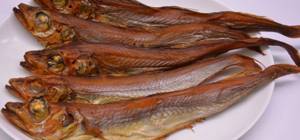
However, even a beginner can cook delicious and aromatic smoked fish if he has a suitable recipe and a smokehouse:
- Use wood chips from fruit trees or alder.
- The shavings are placed in a tank, and a smoking container is attached using a tube.
- The temperature is maintained at no more than 30 degrees so that the structure of the fibers is preserved.
- Smoke the fish for at least 1 day: the larger the size, the longer the cooking.
The taste and smell of cold smoked blue whiting is more intense and attractive.
Recipe from a reader
The note
Igor Poltavsky
Professional fisherman
We rinse the fish under running clean water and cut off the heads to save space in the smokehouse. We lay out the carcasses in layers, sprinkle each of them with salt, add a couple of pinches of paprika.

We put it under oppression for two days. After this, rinse under running cold water and leave to soak in a pan of clean water for one hour. After this, you need to change the water and soak the fish again for an hour.
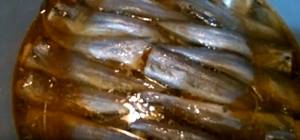
After soaking, the blue whiting needs to be dried a little so that it becomes weathered. To do this, we put it in the dryer and put it on the balcony, to speed up the process we turn on the fan. Drying lasts all night.
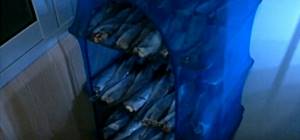
Next comes the standard smoking process. Preparation time: one day. If you smoke on apple wood chips, the fish will be light in color; if you smoke on alder wood chips, it will be yellowish.
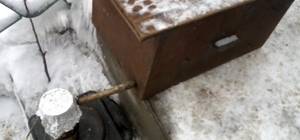
After cooking, the whiting must be sent back to the dryer for a day so that the excess carcinogens contained in the smoke are released. To make the fish drier, the ventilation process must be extended to three days.
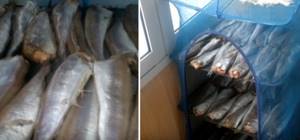
Peculiarities
Blue whiting is the name of a genus of fish belonging to the large cod family. This genus includes only two species: northern and southern whiting, which differ slightly. The northern representative of this genus lives mainly in the north Atlantic, while the southern variety has chosen the southwest Atlantic and Pacific Ocean.
The main difference between the two species, besides the preferred habitat, is the size: the northern species rarely exceeds 35 cm in length and is characterized by a mass of up to 0.7 kg, while the southern variety is slightly larger: its maximum length is 55 cm and weighs up to 1.3 kg. This fish feeds on plankton, and itself serves as a favorite food for both larger relatives in its family, including cod, and for many cetaceans, including dolphins.
The most frequent guest on the shelves of Russian stores is the northern variety: firstly, it is caught closer to the territory of the country, and secondly, the global catch of the northern species of blue whiting exceeds a million tons per year, while the southern species is caught almost 4 times less. Due to the peculiarities of logistics, this product is not sold fresh on the Russian market, so housewives will have to deal with a frozen carcass in any case.
Is it possible for children
Fish is allowed to be included in complementary foods from the first year of life, 25-50 g twice a week. From the age of three you can include it in the daily menu.
Benefits for a growing organism:
- the child’s emotional background is stabilized, he is less irritated and cries;
- perseverance and attention increase;
- the ability to perceive and remember information increases;
- the immune system is strengthened, the child is less likely to get colds and flu;
- Calcium promotes the growth of healthy teeth and strong bones.
Teenagers are also recommended to include blue whiting in their diet; it prevents juvenile skin diseases such as rashes and acne.
